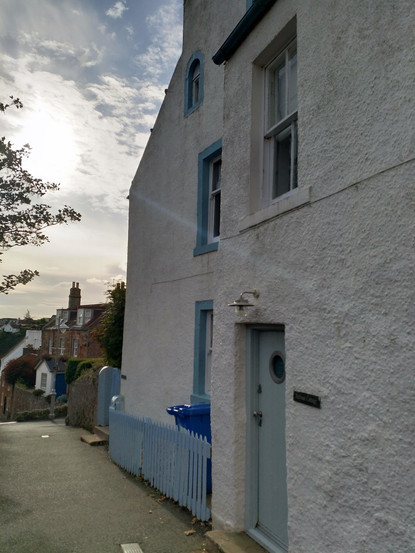Crail: A Seaside Haven in the East Neuk of Fife, Scotland
- Wee Walking Tours
- May 23, 2021
- 4 min read
Updated: Oct 8
Situated in the Kingdom of Fife along Scotland’s east coast is a picturesque seaside village that is filled with history, character, and beauty. With a history of trading with the Dutch dating back to the 900s and a role as one of Scotland’s earliest royal Burghs, Crail is a jewel in the crown of the East Neuk (Scots word for corner) of Fife. Join us as we bring you on a wee exploration of this coastal delight.

As you enter the town of Crail, it quickly becomes obvious that there is a fascinating history to uncover. In fact, our explore and discover mission started as soon as we parked our vehicle as the car park was once the location of one of the town’s medieval markets. Just across the street is one of the best places to learn more about Crail’s history- the Crail Museum and Heritage Centre (check out their website for a virtual tour of the Museum). This wee museum has exhibits telling the history of Crail through the ages. Proof of habitation in the area goes back much further than one may think with archaeological evidence from 2000 BC. Jumping ahead in time to the 12th century, there is mention of the “Burgh of Crail” in an 1150 Charter of King David I. Having that royal status meant that the town could hold markets.

While nearby St Andrews is now known as the ‘home of golf’, there is a fascinating exhibit at the Museum called, ‘Golfing in Crail’. There you can learn how Crail has had a history of golf going back centuries- dating to the Dutch traders who brought a form of the game to Scotland in the 9th century! The innovative Scots of the time eventually took and transformed the game into the modern version we know today. Related to this is an important landmark in Crail- The Golf Inn. The Inn celebrates its 300th anniversary this year and is famous as the location where the Crail Golfing Society was formed in 1786. As a side note, if you are passing through Crail, be sure to stop at the Golf Inn for a delightful mix of an historic atmosphere with modern touches throughout. I can also confirm that their fish and chips takeaway was delicious.

What I found particularly fascinating as you walk around Crail, is the clear influence from other European countries in the town’s architecture. Crail is an historic fishing village and port with a history of trade with the Low Countries (which included the areas we now know as the Netherlands, Belgium, Luxembourg) dating to the 900s. Many of the historic buildings’ Dutch and Flemish influence is evident with their pantiles and crow-stepped gables.

If you look carefully at the historic Tolbooth, the Low Country impact is particularly evident in its unique design. The bell inside is inscribed with the information that it was cast in 1520 in Mechelen (a town in what is now Belgium). Interestingly, that bell was originally in the Parish Church of Crail (also known as St Mary’s Kirk). In 1702 the bells of the Church and Tolbooth were switched, probably because the original Tolbooth bell was smaller, and they wanted the larger one from the Church to be put in the Tolbooth so that it could be better heard in the more central location. The original Tolbooth bell has the inscription- ‘Peter Van den Ghein cast me in the year 1614’. The Van den Ghein family were a famous family of bellfounders in Mechelen. Therefore, both bells were most likely made by the Van den Ghein family in Mechelen (Belgium).

When you visit Crail, be sure to stop by Crail Pottery. Situated in the town’s historic Nethergate, it is a family-run business that was established in 1965. The family has since formed a co-operative to include two other business- Crail Ceramics and Crail Earthenware. Now more than ever, we encourage visitors to support local businesses, and what could be better than a beautiful pot handmade in Scotland? Please check out the video below to learn more about this fascinating family and their business:
Crail has rightfully inspired artists over the centuries. As we walked around the town’s winding cobbled lanes and made our way to the historic harbour, I felt drawn into the splendour of my surroundings. The fishing boats sit quietly in the wee harbour, waiting for their next trip out to catch lobsters, fish, and crabs. Scroll through the photos below to take your own virtual journey through Crail:
There was once a medieval castle where Crail House (built in 1871 and now holiday apartments) now stands. Interestingly, there is limited information in the historical record for Crail Castle and it was already in ruins by the 1500s. Crail is also famous as it is where Marie de Guise (the mother of Mary Queen of Scots) landed upon her arrival in Scotland after her marriage to James V in 1538. It must have been the perfect place for Marie’s introduction to Scotland with its idyllic and quaint setting.

I hope you have enjoyed our brief journey to Crail in the East Neuk of Fife. If you are visiting nearby or driving through the area, we highly recommend you stop and take the time to explore this lovely seaside village as there is much more to see and do! The Kingdom of Fife is one of our favourite places to explore in Scotland, so stay tuned for more. In the meantime, you can follow our adventures on our various social channels- Facebook, Bluesky, Instagram, and YouTube.
Until next time- Explore & Discover!
























